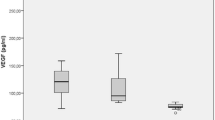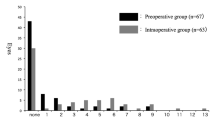Abstract
Background
Cytokine levels are elevated in the ocular fluid of diabetic patients. It is unclear whether aqueous humor levels of vascular endothelial growth factor (VEGF) and interleukin-6 (IL-6) are related to the vitreous fluid levels of these substances and to the progression of diabetic retinopathy.
Methods
Aqueous humor and vitreous fluid samples were obtained during cataract and vitreous surgery from ten eyes of ten patients with diabetic macular edema and 26 eyes of 26 patients with proliferative diabetic retinopathy (PDR). The VEGF and IL-6 levels in aqueous humor, vitreous fluid, and plasma were measured by enzyme-linked immunosorbent assay.
Results
VEGF and IL-6 levels in aqueous humor were significantly correlated with those in vitreous fluid (ρ=0.793 and ρ=0.737, respectively). VEGF levels in aqueous humor and vitreous fluid were significantly correlated with the corresponding IL-6 levels (ρ=0.631 and ρ=0.687, respectively). The aqueous and vitreous levels of VEGF were significantly correlated with the severity of diabetic retinopathy (ρ=0.659 and ρ=0.771, respectively). Aqueous and vitreous levels of IL-6 were also significantly correlated with the severity of diabetic retinopathy (ρ=0.742 and ρ=0.746, respectively). Aqueous and vitreous levels of both VEGF and IL-6 were significantly higher in the patients with active PDR than those in quiescent PDR.
Conclusions
Our results suggest that there is a significant relationship between VEGF and IL-6 levels in aqueous humor and in vitreous fluid. Measurement of the aqueous levels of VEGF and IL-6 may be useful to analyze the pathogenesis of diabetic retinopathy and to predict disease activity.


Similar content being viewed by others
References
Abu El Asrar AM, Maimone D, Morse PH et al (1992) Cytokines in the vitreous of patients with proliferative diabetic retinopathy. Am J Ophthalmol 114:731–736
Aiello LP, Avery RL, Arrigg PG et al (1994) Vascular endothelial growth factor in ocular fluid of patients with diabetic retinopathy and other retinal disorders. N Engl J Med 331:1480–1487
Aiello LP, Bursell SE, Clermont A et al (1997) Vascular endothelial growth factor-induced retinal permeability is mediated by protein kinase C in vivo and suppressed by an orally effective B-isoform-selective inhibitor. Diabetes 46:1473–1480
Burgos R, Simo R, Audi L et al (1997) Vitreous levels of vascular endothelial growth factor are not influenced by its serum concentrations in diabetic retinopathy. Diabetologia 40:1107–1109
Cai J, Boulton M (2002) The pathogenesis of diabetic retinopathy. Old concepts and new questions. Eye 16:242–260
Chakrbarti S, Cukiernik M, Hleeto D et al (2002) Role of vasoactive factors in the pathogenesis of early changes in diabetic retinopathy. Diabetes Metab Res Rev 16:393–407
Cohen T, Nahari D, Cerem LW et al (1996) Interleukin 6 induces the expression of vascular endothelial growth factor. J Biol Chem 271:736–741
Cubitt CL, Lausch RN, Oakes JE (1995) Differences in interleukin-6 gene expression between cultured human corneal epithelial cells and keratocytes. Invest Ophthalmol Vis Sci 36:330–336
Early Treatment Diabetic Retinopathy Study Research Group (1985) Photocoagulation for diabetic macular edema. Early Treatment Diabetic Retinopathy Study report 1. Arch Ophthalmol 103:1796–1806
Early Treatment Diabetic Retinopathy Study Research Group (1991) Grading diabetic retinopathy from stereoscopic color fundus photographs. An extension of the modified Airlie House classification. ETDRS Report Number 10. Ophthalmology 98:786–806
Early Treatment Diabetic Retinopathy Study Research Group (1991) Fundus photographic risk factors for progression of diabetic retinopathy. ETDRS Report Number 12. Ophthalmology 98:823–833
Elner VM, Scales W, Elner SG et al (1992) Interleukin-6 (IL-6) gene expression and secretion by cytokine-stimulated human retinal epithelium cells. Exp Eye Res 54:361–368
Funatsu H, Yamashita H, Shimizu E et al (2001) Relationship between vascular endothelial growth factor and interleukin-6 in diabetic retinopathy. Retina 21:469–477
Funatsu H, Yamashita H, Noma H et al (2002) Increased levels of vascular endothelial growth factor and interleukin-6 in the aqueous humor of diabetic macular edema. Am J Ophthalmol 133:70–77
Katsura Y, Okano T, Noritake M et al (1998) Hepatocyte growth factor in vitreous fluid of patients with proliferative diabetic retinopathy and other retinal disorders. Diabetes Care 21:1759–1763
Lip PL, Belgore F, Blann AD et al (2000) Plasma VEGF and soluble VEGF receptor Flt-1 in proliferative retinopathy: Relationship to endothelial dysfunction and laser treatment. Invest Ophthalmol Vis Sci 41:2115–2119
Lotz M (1995) Interleukin-6. A comprehensive review. Cancer Treat Res 80:209–233
Lutty GA, McLeod S, Merges C et al (1996) Localization of vascular endothelial growth factor in human retina and choroid. Arch Ophthalmol 114:971–977
Maruo N, Morita I, Shirao M, Murota S (1992) IL-6 increases endothelial permeability in vitro. Endocrinology 131:710–714
Morohoshi M, Fujisawa K, Uchimura I, Numano F (1996) Glucose-dependent interleukin 6 and tumor necrosis factor production by human peripheral blood monocytes in vitro. Diabetes 45:954–959
Punglia RS, Lu M, Hsu J et al (1997) Regulation of vascular endothelial growth factor expression by insulin-like growth factor. Diabetes 46:1619–1626
SAS Institute Inc (1997) SAS/STAT Software. Changes and Enhancements through. Release 6.12., Cary, NC, USA, 1–1167
Scheiki D, Itin A, Soffer D, Keshet E (1992) Vascular endothelial growth factor induced by hypoxia may mediate hypoxia-initiated angiogenesis. Nature 359:843–845
Yan SF, Tritto I, Pinsky D et al (1995) Induction of interleukin-6 (IL-6) by hypoxia in vascular cells. J Biol Chem 270:11463–11471
Acknowledgments
We thank Drs Shigehiko Kitano, Erika Shimizu, Yuichiro Nakanishi, Koji Makita, and Kensuke Haruyama for their assistance in collecting the vitreous and plasma samples and in performing the ophthalmological examinations. We also thank Drs Yasuhiko Iwamoto and Naoko Iwasaki for their assistance in performing the internal medical examinations. Finally, we would like to thank Katsunori Shimada (Department of Biostatistics, STATZ Institute, Co., Ltd) for his assistance in conducting the statistical analysis. Supported by a Health Science Research Grant (#10060101 to Drs Funatsu, Hori, and Yamashita) from the Japanese Ministry of Health, Labor and Welfare (Tokyo, Japan).
Author information
Authors and Affiliations
Corresponding author
Rights and permissions
About this article
Cite this article
Funatsu, H., Yamashita, H., Noma, H. et al. Aqueous humor levels of cytokines are related to vitreous levels and progression of diabetic retinopathy in diabetic patients. Graefe's Arch Clin Exp Ophthalmol 243, 3–8 (2005). https://doi.org/10.1007/s00417-004-0950-7
Received:
Revised:
Accepted:
Published:
Issue Date:
DOI: https://doi.org/10.1007/s00417-004-0950-7




